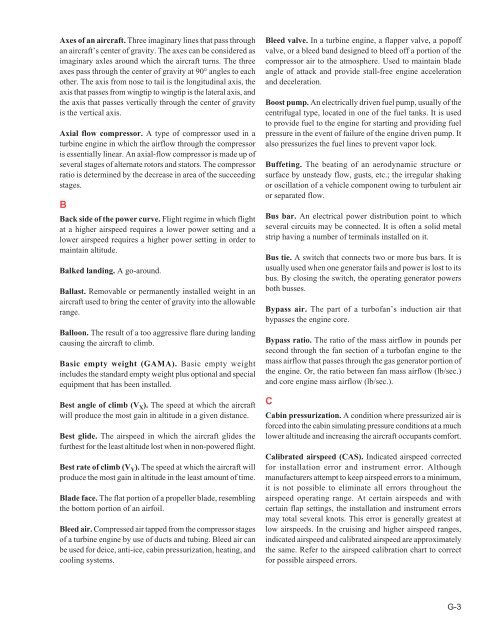Create successful ePaper yourself
Turn your PDF publications into a flip-book with our unique Google optimized e-Paper software.
Axes of an aircraft. Three imaginary lines that pass through<br />
an aircraft’s center of gravity. The axes can be considered as<br />
imaginary axles around which the aircraft turns. The three<br />
axes pass through the center of gravity at 90° angles to each<br />
other. The axis from nose to tail is the longitudinal axis, the<br />
axis that passes from wingtip to wingtip is the lateral axis, and<br />
the axis that passes vertically through the center of gravity<br />
is the vertical axis.<br />
Axial flow compressor. A type of compressor used in a<br />
turbine engine in which the airflow through the compressor<br />
is essentially linear. An axial-flow compressor is made up of<br />
several stages of alternate rotors and stators. The compressor<br />
ratio is determined by the decrease in area of the succeeding<br />
stages.<br />
B<br />
Back side of the power curve. Flight regime in which flight<br />
at a higher airspeed requires a lower power setting and a<br />
lower airspeed requires a higher power setting in order to<br />
maintain altitude.<br />
Balked landing. A go-around.<br />
Ballast. Removable or permanently installed weight in an<br />
aircraft used to bring the center of gravity into the allowable<br />
range.<br />
Balloon. The result of a too aggressive flare during landing<br />
causing the aircraft to climb.<br />
Basic empty weight (GAMA). Basic empty weight<br />
includes the standard empty weight plus optional and special<br />
equipment that has been installed.<br />
Best angle of climb (V X ). The speed at which the aircraft<br />
will produce the most gain in altitude in a given distance.<br />
Best glide. The airspeed in which the aircraft glides the<br />
furthest for the least altitude lost when in non-powered flight.<br />
Best rate of climb (V Y ). The speed at which the aircraft will<br />
produce the most gain in altitude in the least amount of time.<br />
Blade face. The flat portion of a propeller blade, resembling<br />
the bottom portion of an airfoil.<br />
Bleed air. Compressed air tapped from the compressor stages<br />
of a turbine engine by use of ducts and tubing. Bleed air can<br />
be used for deice, anti-ice, cabin pressurization, heating, and<br />
cooling systems.<br />
Bleed valve. In a turbine engine, a flapper valve, a popoff<br />
valve, or a bleed band designed to bleed off a portion of the<br />
compressor air to the atmosphere. Used to maintain blade<br />
angle of attack and provide stall-free engine acceleration<br />
and deceleration.<br />
Boost pump. An electrically driven fuel pump, usually of the<br />
centrifugal type, located in one of the fuel tanks. It is used<br />
to provide fuel to the engine for starting and providing fuel<br />
pressure in the event of failure of the engine driven pump. It<br />
also pressurizes the fuel lines to prevent vapor lock.<br />
Buffeting. The beating of an aerodynamic structure or<br />
surface by unsteady flow, gusts, etc.; the irregular shaking<br />
or oscillation of a vehicle component owing to turbulent air<br />
or separated flow.<br />
Bus bar. An electrical power distribution point to which<br />
several circuits may be connected. It is often a solid metal<br />
strip having a number of terminals installed on it.<br />
Bus tie. A switch that connects two or more bus bars. It is<br />
usually used when one generator fails and power is lost to its<br />
bus. By closing the switch, the operating generator powers<br />
both busses.<br />
Bypass air. The part of a turbofan’s induction air that<br />
bypasses the engine core.<br />
Bypass ratio. The ratio of the mass airflow in pounds per<br />
second through the fan section of a turbofan engine to the<br />
mass airflow that passes through the gas generator portion of<br />
the engine. Or, the ratio between fan mass airflow (lb/sec.)<br />
and core engine mass airflow (lb/sec.).<br />
C<br />
Cabin pressurization. A condition where pressurized air is<br />
forced into the cabin simulating pressure conditions at a much<br />
lower altitude and increasing the aircraft occupants comfort.<br />
Calibrated airspeed (CAS). Indicated airspeed corrected<br />
for installation error and instrument error. Although<br />
manufacturers attempt to keep airspeed errors to a minimum,<br />
it is not possible to eliminate all errors throughout the<br />
airspeed operating range. At certain airspeeds and with<br />
certain flap settings, the installation and instrument errors<br />
may total several knots. This error is generally greatest at<br />
low airspeeds. In the cruising and higher airspeed ranges,<br />
indicated airspeed and calibrated airspeed are approximately<br />
the same. Refer to the airspeed calibration chart to correct<br />
for possible airspeed errors.<br />
G-3


